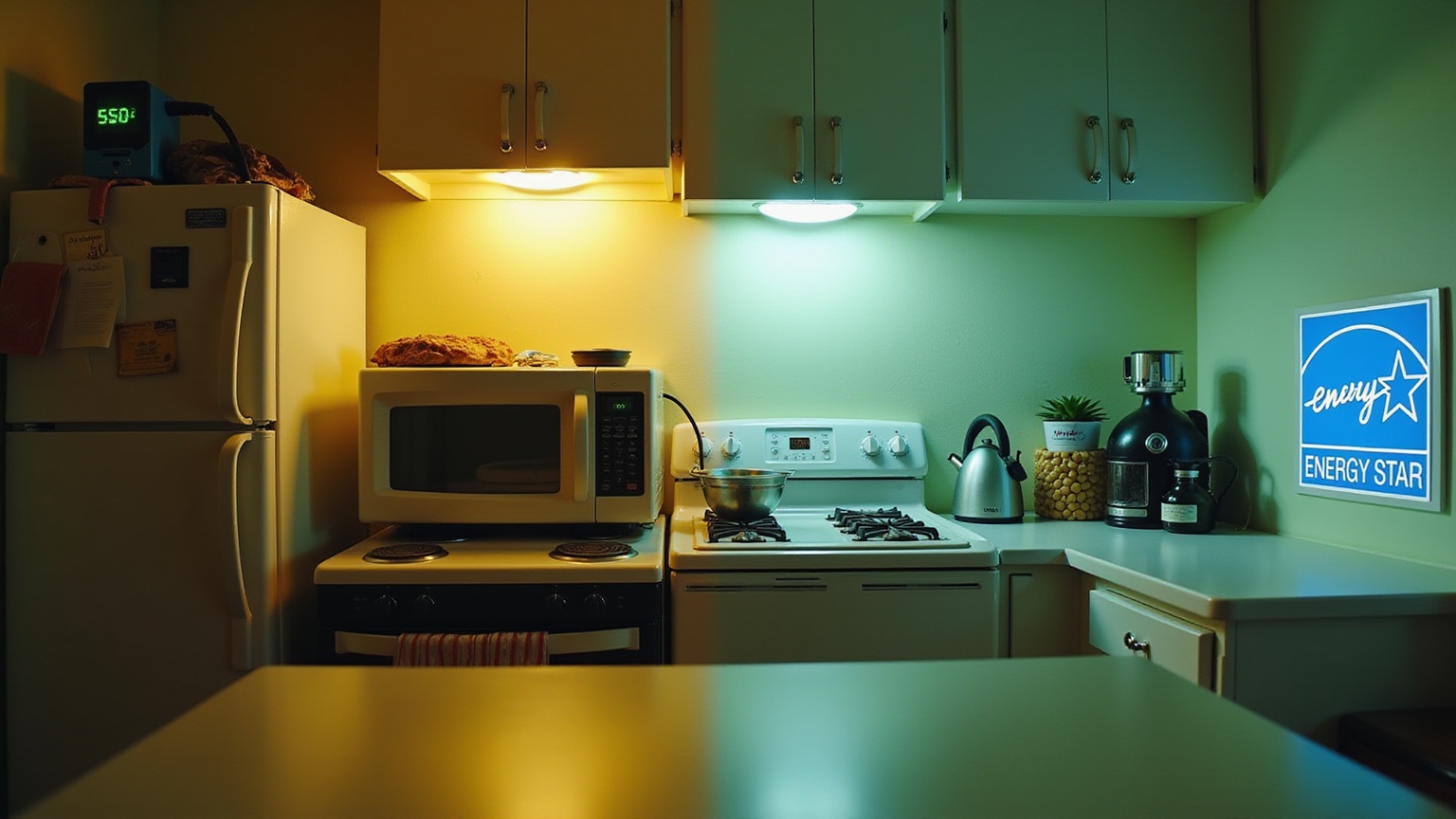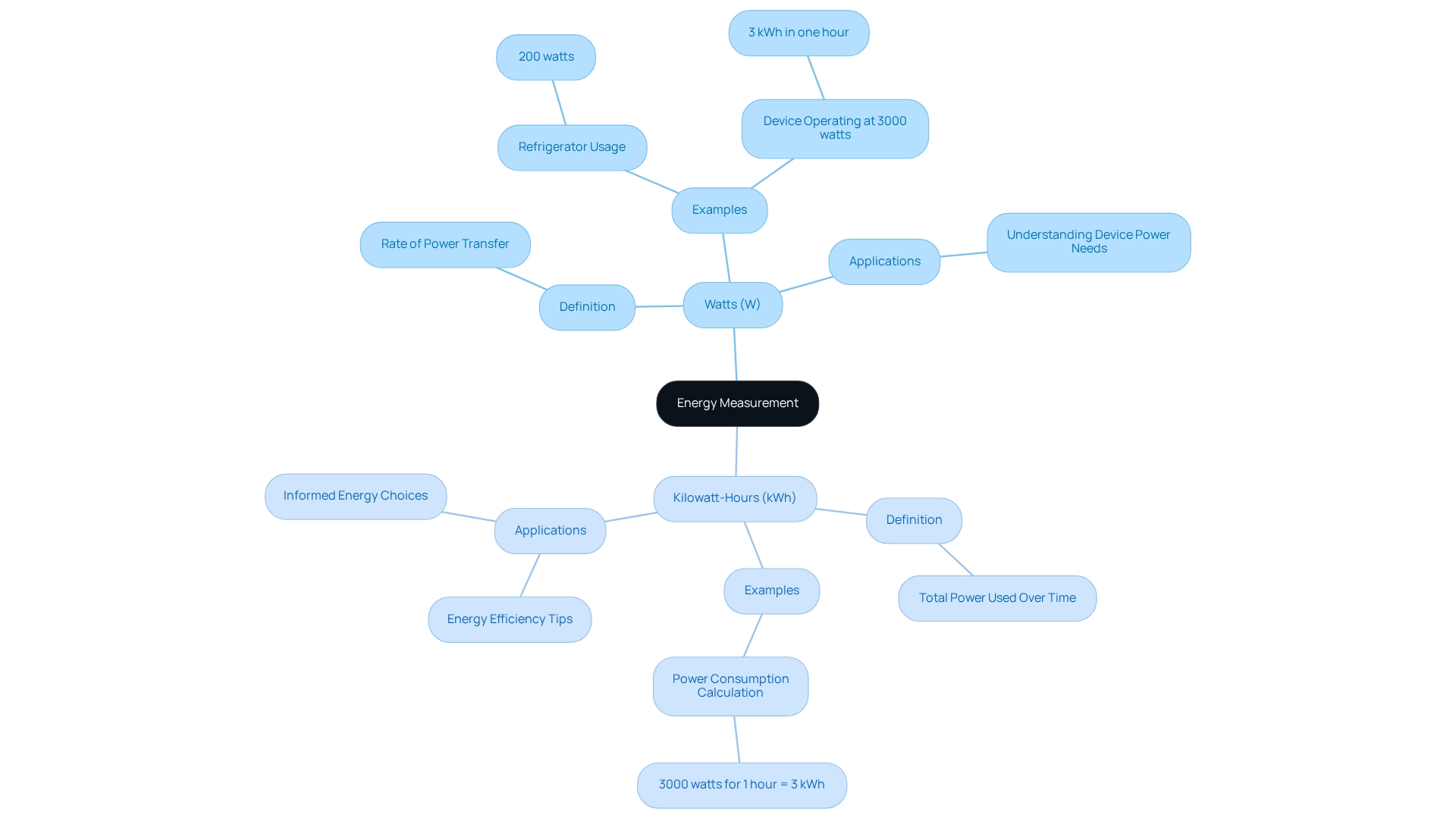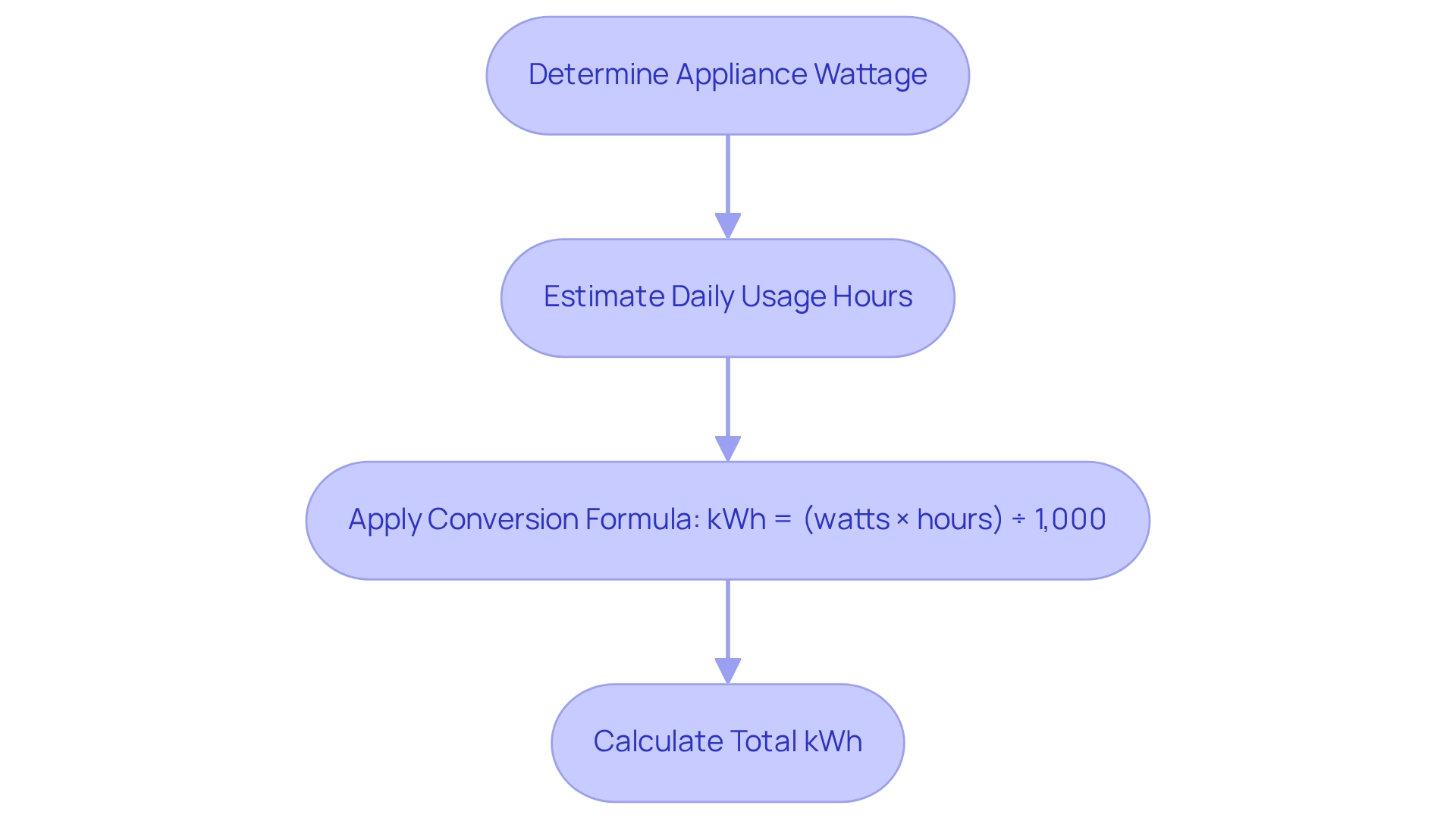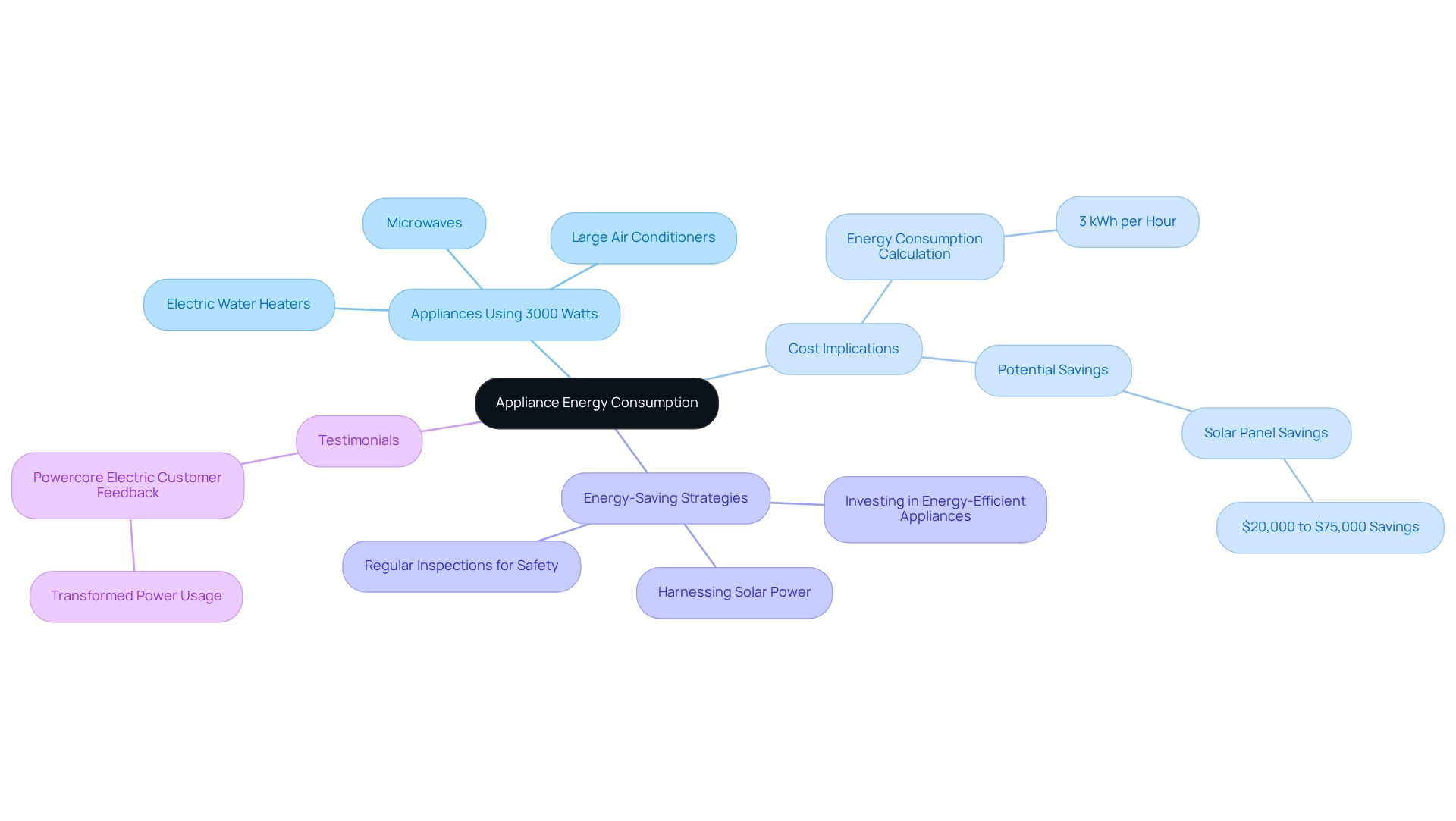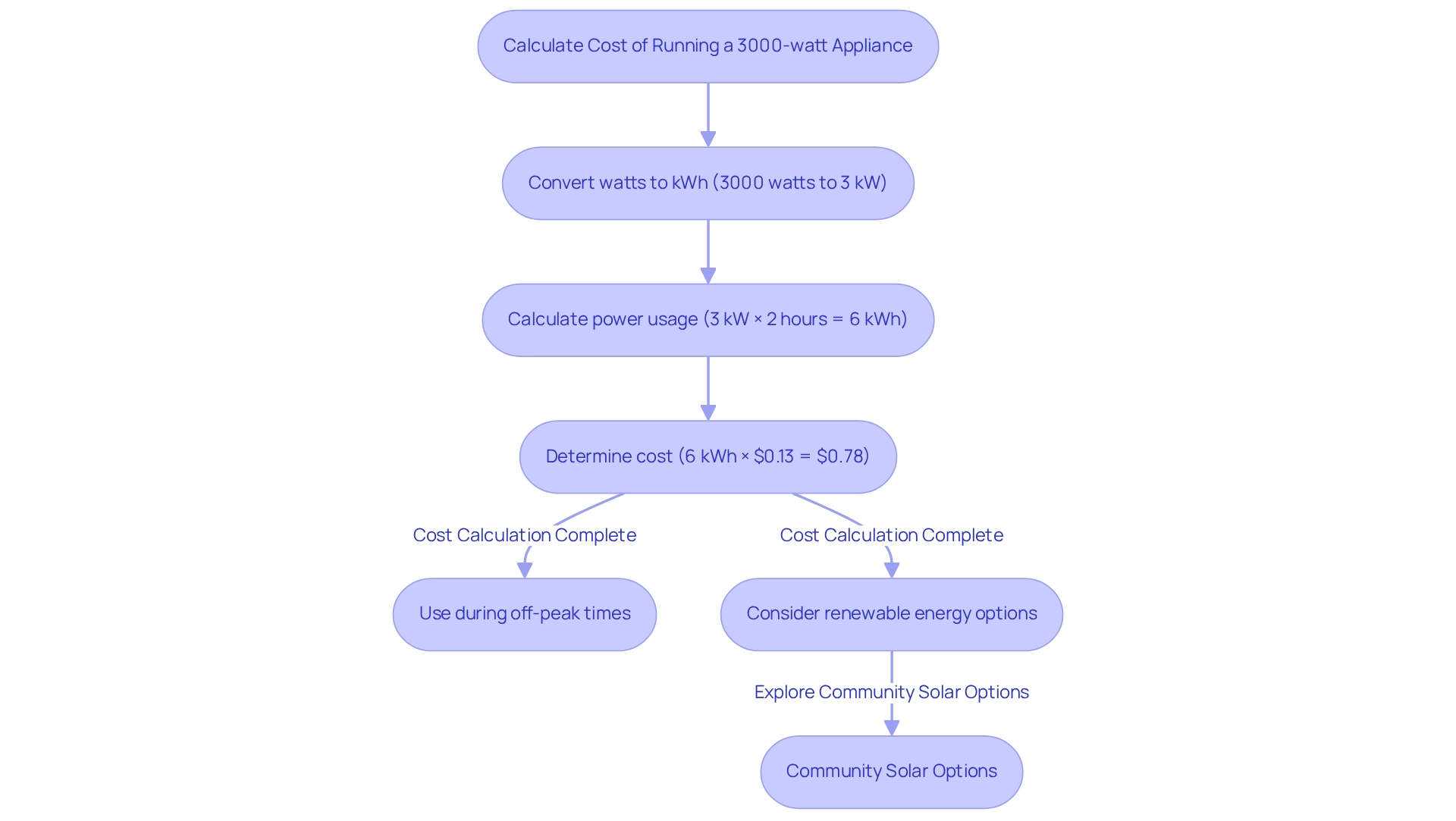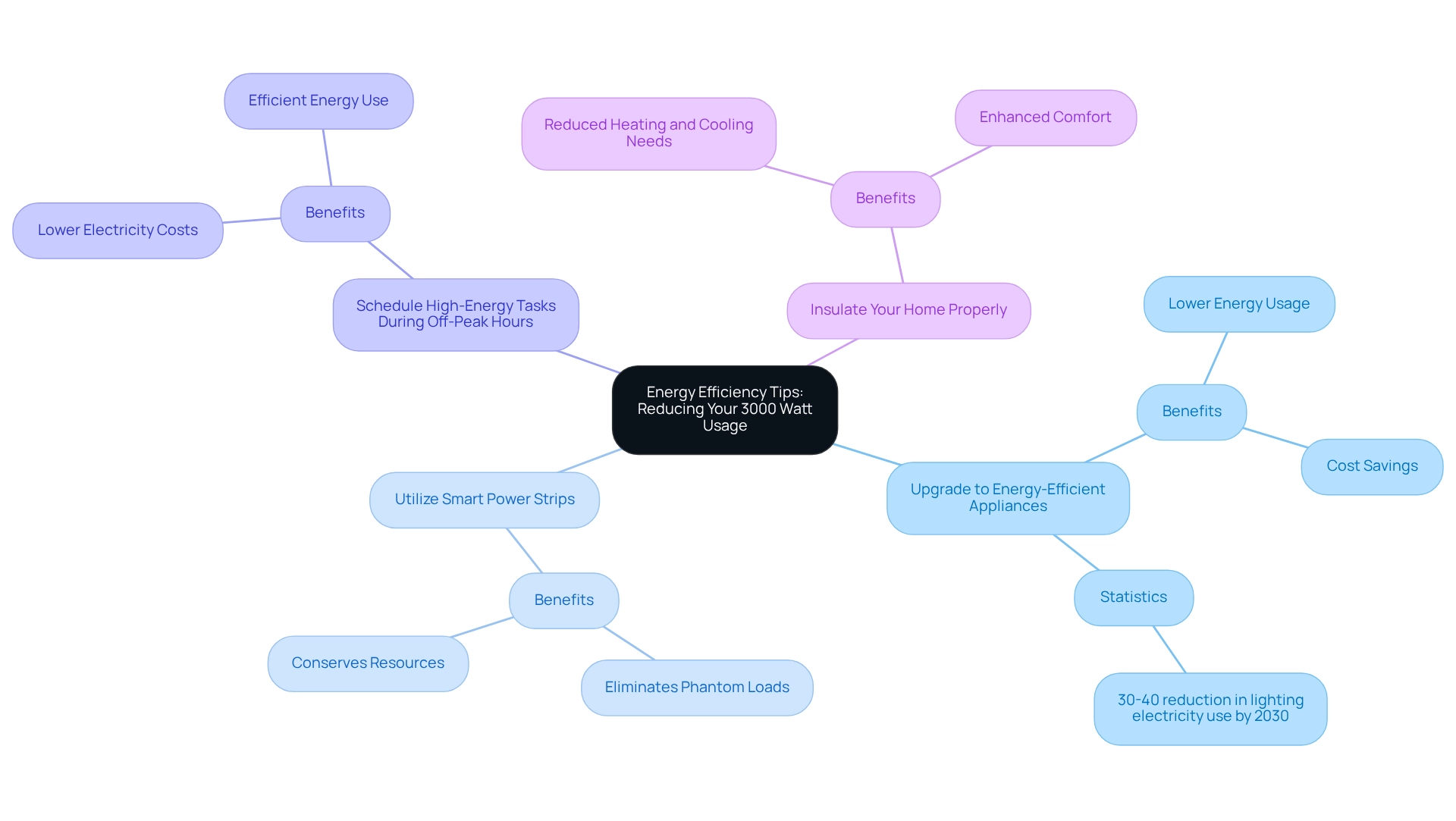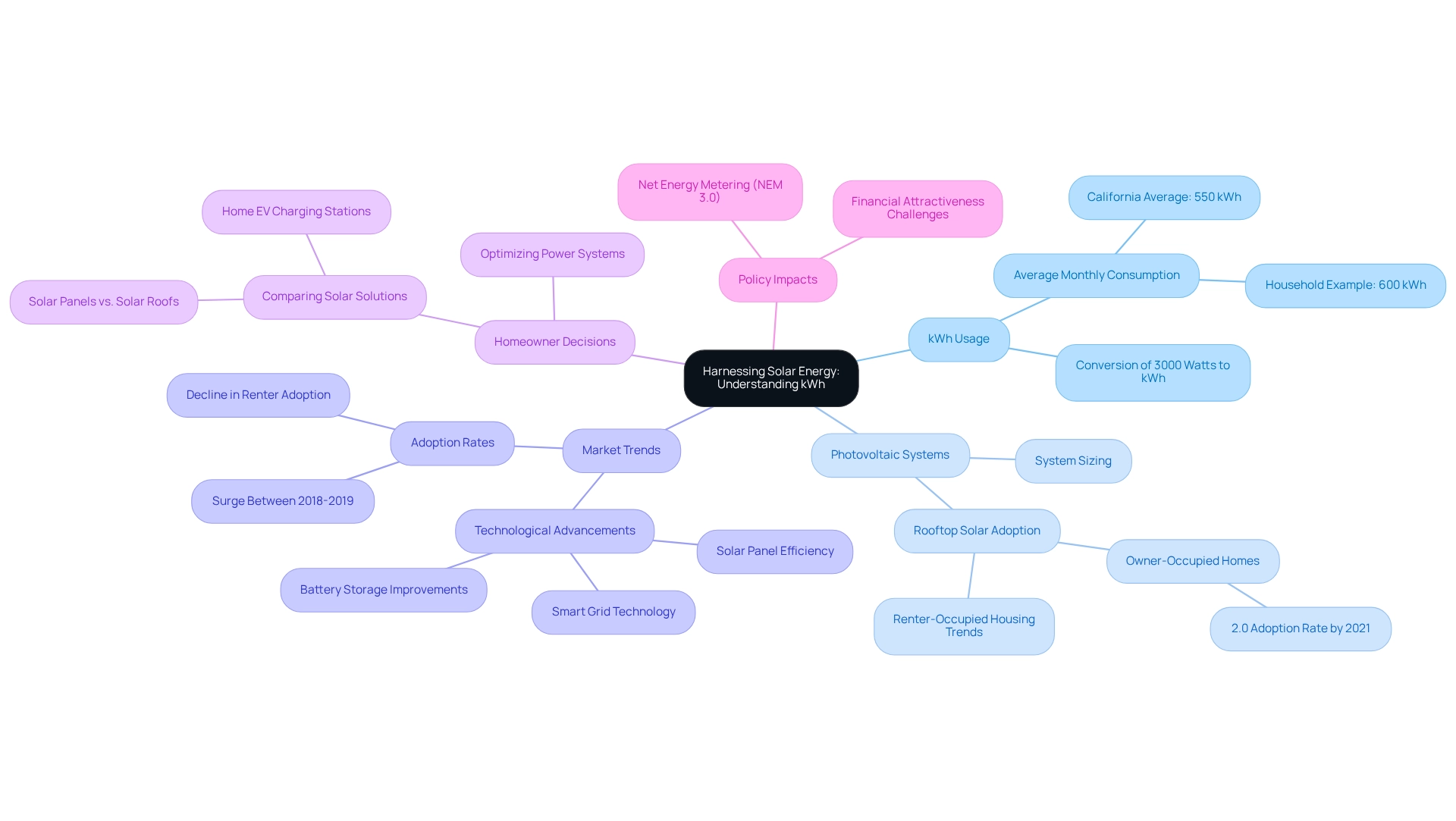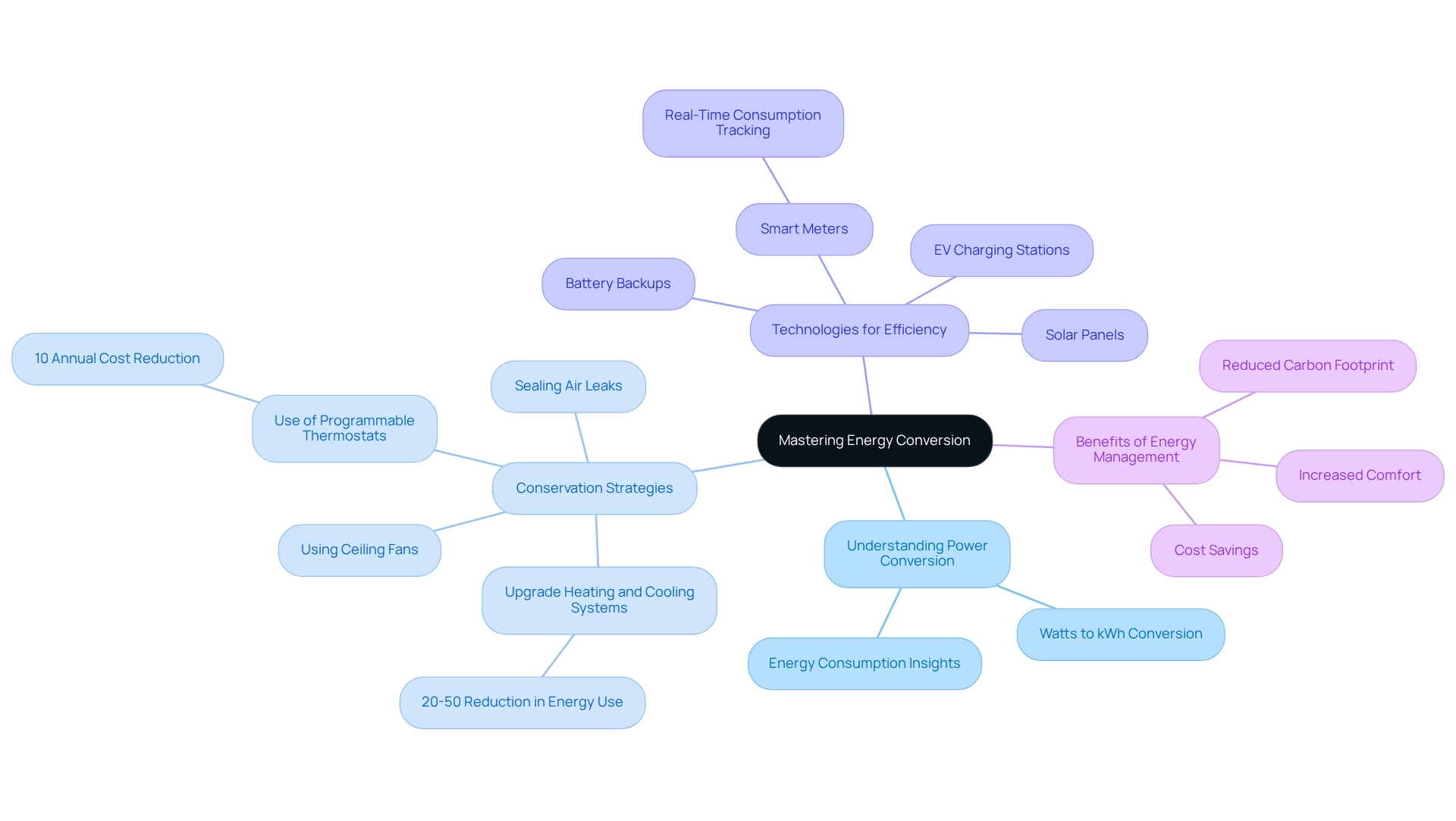Overview
This article addresses a common concern for homeowners: managing energy bills. It focuses on how to convert 3000 watts to kilowatt-hours (kWh) and the implications of this conversion for effectively monitoring energy consumption and costs. Understanding this conversion is essential for homeowners who want to make informed decisions about appliance efficiency and explore renewable energy solutions. By doing so, you can ultimately lead to reduced utility bills and a more sustainable lifestyle.
We understand that navigating energy usage can feel overwhelming, but there are meaningful steps you can take. The benefits of solar energy and achieving energy independence are not just dreams; they are attainable goals that can transform your home and finances. Imagine the peace of mind that comes with knowing you are making a positive impact on both your wallet and the environment.
Together, we can explore these solutions and foster a community that prioritizes sustainability. Let’s work towards a brighter future where your energy choices reflect your values. If you’re ready to take action and learn more about how to manage your energy usage effectively, we’re here to support you every step of the way.
Introduction
In a world increasingly driven by energy consumption, we understand that navigating the intricacies of energy measurement can feel overwhelming for homeowners. Watts and kilowatt-hours are not just technical terms; they represent the lifeblood of energy management, influencing everything from monthly bills to appliance efficiency.
As energy costs continue to rise, knowledge about how much power devices consume can empower you to make informed choices. Together, we can work towards significant savings and a reduced carbon footprint.
This article delves into the essentials of watts and kilowatt-hours, offering practical insights into energy consumption, cost calculations, and strategies for enhancing efficiency—all while highlighting how trusted partners like Powercore Electric can guide you through the complex landscape of energy solutions.
Let’s explore this journey together, ensuring you feel supported and informed every step of the way.
Defining Watts and Kilowatt-Hours: The Basics of Energy Measurement
Understanding the difference between watts (W) and kilowatt-hours (kWh) is crucial for homeowners concerned about their energy bills. Watts measure the rate at which power is transferred, while kilowatt-hours quantify the total power used over time. To put it simply, one kilowatt equals 1,000 watts, and a kilowatt-hour represents the power consumed by a device using 1,000 watts for one hour. For instance, if a device operates at 3000 watts for one hour, it will consume 3 kWh of power.
We understand that rising power expenses can be daunting. By grasping how much power your devices use, you can make informed choices that lead to potential savings and greater appliance efficiency. Powercore Electric, serving the California community for over 30 years, emphasizes the importance of this knowledge in helping residents make better energy choices, especially when considering options like solar panels, battery backups, and EV charging stations.
It’s common to feel overwhelmed, as recent statistics reveal that many households are unaware of their usage patterns, which can lead to unexpected costs. By distinguishing between watts and kilowatt-hours, homeowners can manage their consumption more effectively and identify opportunities for improving efficiency. As power specialist Max Roser highlights, understanding basic power usage is essential for making informed decisions about energy consumption.
Consider real-world examples: a typical refrigerator might use about 200 watts, translating to roughly 4.8 kWh daily. It’s also important to acknowledge that total power and electricity usage data does not reveal the sources of power or changes over time, which can further enlighten residents about their energy options. By understanding these measurements, homeowners can make strategic decisions about their power usage, ultimately leading to lower bills and a reduced carbon footprint.
In summary, grasping the difference between watts and kilowatt-hours goes beyond academic knowledge; it’s a practical skill that empowers homeowners to take control of their energy usage and expenses. Powercore Electric’s community-focused approach ensures that clients receive personalized service and support, positioning them as a trusted partner in navigating energy solutions, including optimal battery options and solar panel performance. Together, let’s work towards a more sustainable future.
How to Convert Watts to Kilowatt-Hours: Step-by-Step Guide
Understanding your energy bills can often feel overwhelming, but it’s essential for managing your household expenses. To convert watts to kilowatt-hours, you can use the formula:
- kWh = (watts × hours) ÷ 1,000.
For instance, if you operate a 3000-watt appliance for 2 hours, the calculation would be:
- kWh = (3000 W × 2 h) ÷ 1000 = 6 kWh.
This simple calculation is crucial for grasping how your appliances affect your electricity bill over time.
Many homeowners can greatly benefit from tracking their power consumption. Imagine having a complete home monitoring system that allows you to keep an eye on the usage of different devices, including those that function at 240 volts. This system can provide you with valuable insights into your consumption patterns, helping you identify opportunities to reduce usage and lower your expenses.
In California, where utility costs can be particularly high, understanding these calculations becomes even more relevant. Data suggests that a panel system for the typical U.S. residence can cover its costs in as few as 5-6 years, highlighting the financial advantages of efficiency and expense control for property owners. Moreover, selecting the right solar battery can enhance your power storage, ensuring that surplus energy produced during the day can be utilized during peak times or at night, further maximizing your energy usage.
To manually calculate your yearly power consumption, start by estimating the daily usage hours for each appliance, find its wattage, and apply the conversion formula. This method not only aids in planning for utility expenses but also encourages a shift towards more sustainable practices, resonating with the growing trend of eco-conscious living. If you seek more detailed guidance on how solar panels work or wish to explore the best solar battery options, we encourage you to consult Powercore Electric’s user manual. Together, we can work towards a more sustainable future for your home.
Understanding Appliance Energy Consumption: What Uses 3000 Watts?
Many homeowners share a common concern: the rising costs of energy bills. It’s not uncommon to feel overwhelmed by the power consumption of household appliances, especially those that operate at approximately 3000 watts, such as electric water heaters, large air conditioners, and certain kitchen devices like microwaves. Understanding which devices fall into this category is crucial for managing resources efficiently. For instance, when calculating the conversion of 3000 watts to kWh, an appliance running for just one hour consumes 3 kWh of power, which can lead to a significant increase in monthly utility costs.
Electric water heaters, in particular, are among the largest power consumers in a home, typically consuming about 3000 watts. Large air conditioning units can also reach this level, especially during peak summer usage. By comprehending the power consumption of these appliances, homeowners can make informed choices about their usage and explore potential savings.
Imagine the relief of reducing those expenses! Investing in energy-efficient options or harnessing solar power can lead to substantial savings. Numerous case studies illustrate the effectiveness of solar-powered heaters in residential settings. For example, a household in Southern California saw an incredible reduction of over 70% in their utility costs after installing a water heating system with a heat exchanger.
Powercore Electric, serving the California community for over 30 years, emphasizes that homeowners can save between $20,000 and $75,000 on electricity over the lifespan of a solar panel system. This clearly demonstrates the financial benefits of transitioning to renewable energy sources. Their dedicated team ensures high-quality installations and maintenance, supporting residents in their energy efficiency efforts. One satisfied customer shared, “Powercore Electric transformed our power usage and helped us save significantly on our bills!”
This testimonial highlights Powercore Electric’s commitment to quality service and community support.
Moreover, it’s essential to regularly inspect the plugs and wires of household appliances for safety, as wear and tear can occur over time. By being mindful of the power requirements of common household devices and taking necessary precautions, homeowners can strategize their usage more effectively and enhance their overall efficiency. Together, we can work towards a more sustainable and cost-effective energy future.
Calculating the Cost of Running Appliances at 3000 Watts: What to Expect on Your Bill
Understanding the cost of running a 3000-watt appliance can be daunting, especially when it comes to managing your energy bills. To calculate the consumption in kilowatt-hours (kWh), simply convert watts to kWh and multiply by your electricity rate, expressed in cents per kWh. For example, if your electricity rate is $0.13 per kWh, running a 3000-watt appliance for 2 hours would look like this:
- Convert watts to kWh: 3000 watts is equivalent to 3 kW.
- Calculate power usage: 3 kW × 2 hours = 6 kWh.
- Determine the cost: 6 kWh × $0.13 = $0.78.
This straightforward calculation can empower residents to predict their utility expenses effectively. Given that California’s average electricity rates are among the highest in the nation, with a staggering surcharge of 236.6% compared to the rest of the U.S. for industrial consumers as of November 2023, understanding these costs is vital for managing your utility bills. In 2025, California residents will face average electricity rates significantly above the national average, making it essential to monitor and optimize appliance usage.
We understand that managing high-wattage devices can feel overwhelming. However, by strategically planning their operation during off-peak times or when renewable power is available, residents can effectively reduce their expenses. Additionally, community energy options provide an alternative for those unable to install renewable energy systems, potentially leading to annual savings of around $358 for the average electricity consumer in California. Together, we can take proactive steps in resource management, significantly mitigating the impact of rising utility costs.
Furthermore, investing in photovoltaic systems and electric vehicle charging solutions from Powercore Electric can enhance both savings and efficiency. As conventional electricity costs continue to rise, transitioning to solar power not only offers long-term financial benefits but also contributes to environmental sustainability. Powercore Electric’s dedicated team of specialists ensures high-quality installations and maintenance, providing essential support for homeowners looking to improve their resource consumption and embrace a more sustainable lifestyle. Let’s work together towards a brighter, more energy-independent future.
Energy Efficiency Tips: Reducing Your 3000 Watt Usage for a Greener Home
To effectively reduce your energy consumption and alleviate concerns about rising energy bills, consider converting your 3000 watts to kWh through the following strategies:
-
Upgrade to Energy-Efficient Appliances: Investing in ENERGY STAR certified appliances can significantly reduce your energy usage. These appliances are designed to utilize less power while maintaining performance, leading to substantial savings on your utility bills.
As Kristina Zagame points out, the widespread adoption of energy-efficient LED lighting is projected to reduce global electricity use for lighting by 30-40% by 2030. This highlights the importance of energy-efficient lighting solutions.
-
Utilize Smart Power Strips: Smart power strips help eliminate phantom loads—energy consumed by devices when they are turned off but still plugged in. By disconnecting power to these devices when not in use, you can conserve a significant amount of resources over time.
-
Schedule High-Energy Tasks During Off-Peak Hours: Many utility companies offer lower rates during off-peak hours. By running dishwashers, washing machines, and other high-energy appliances during these times, you can take advantage of reduced electricity costs.
-
Insulate Your Home Properly: Adequate insulation reduces the necessity for heating and cooling, which are major contributors to power consumption. Ensuring that your home is properly insulated can lead to reduced power consumption and enhanced comfort.
These approaches not only assist in decreasing your utility costs but also foster a more sustainable lifestyle. A recent survey showed that 40% of homeowners have changed their views on efficiency, influenced by product enhancements and cost reductions. This growing awareness underscores the importance of adopting energy-efficient practices in our homes.
By implementing these modifications, you can actively participate in the initiative for a more sustainable future while enjoying the financial rewards of decreased power usage.
For those seeking to improve their efficiency further, Powercore Electric is here to support you with reliable general electrical services in Northern California, including photovoltaic panel installations, battery backups, and EV charging stations. Our dedicated team is ready to assist you in executing these strategies efficiently, ensuring you optimize your savings while safeguarding your home and the environment. Powercore Electric’s photovoltaic panel installations can greatly decrease your electricity expenses, while our battery backups offer dependable storage solutions.
Additionally, our EV charging stations make it convenient for you to charge your electric vehicle at home, contributing to a more sustainable lifestyle. Together, we can work towards a brighter, more energy-efficient future.
Harnessing Solar Energy: How Understanding kWh Can Benefit Your Home
Understanding your kWh usage, particularly when converting 3000 watts to kWh, is vital as you explore renewable power solutions and evaluate service providers like Powercore Electric. By accurately calculating your average power consumption and converting 3000 watts to kWh, you can determine the appropriate size of the photovoltaic system necessary to meet your energy needs. For example, if your household consumes approximately 600 kWh each month, grasping how to convert 3000 watts to kWh can guide you in designing a well-sized photovoltaic system that significantly reduces that usage, resulting in lower electricity costs and greater energy independence.
In California, where the average monthly kWh usage for homes is around 550 kWh, knowing how to convert 3000 watts to kWh becomes even more crucial. This typical consumption directly influences how homeowners configure their photovoltaic systems to ensure they efficiently meet their energy demands. With California leading the way in renewable power adoption, many homeowners are turning to photovoltaic solutions to tackle rising utility costs and secure reliable power sources.
Notably, nearly 2.0 percent of owner-occupied residences in the state had installed rooftop panels by 2021, underscoring a strong commitment to renewable energy. Trends indicate that while owner-occupied housing continues to embrace renewable energy, renter-occupied housing has seen a decline, reflecting shifting market dynamics.
Moreover, the benefits of understanding kWh extend beyond simple calculations. Homeowners can leverage this knowledge to optimize their power systems, ensuring they harness the full potential of their installations, especially when considering the conversion of 3000 watts to kWh. For instance, case studies reveal that property owners who have adopted photovoltaic systems under the 200% guideline have experienced significant reductions in their utility expenses and increased property values.
As advancements in photovoltaic technology continue to improve efficiency and battery storage capabilities, the financial attractiveness of this energy source remains robust, despite recent fluctuations in adoption trends. However, the introduction of the new Net Metering policy (NEM 3.0) may pose challenges for future renewable energy adoption, making it essential for homeowners to stay informed about these changes.
By recognizing the significance of converting 3000 watts to kWh in relation to renewable energy, homeowners can make informed decisions that enhance their autonomy and contribute to a sustainable future. This understanding is crucial when comparing solar panels to solar roofs and considering the installation of home EV charging stations, ensuring you choose the best value in solar power solutions. Together, we can navigate these choices to create a brighter, more sustainable future.
Key Takeaways: Mastering Energy Conversion for Better Home Management
Mastering the conversion of 3000 watts to kWh is essential for effective home power management. We understand that managing energy bills can be a source of stress for many homeowners. By precisely assessing power usage, residents can identify high-usage devices and apply focused cost-saving strategies, leading to substantial decreases in expenses. For instance, upgrading heating and cooling systems can reduce consumption by 20-50%, while programmable thermostats can lower costs by around 10% each year.
Furthermore, initiatives such as Mass Save provide more than a 75% discount on new insulation and full coverage on air sealing, offering significant motivations for property owners to contemplate efficient upgrades.
Property owners who successfully regulate their consumption frequently observe concrete advantages. A case study on regulating indoor temperatures revealed that simple modifications, such as using ceiling fans to circulate warm air and sealing air leaks around doors and windows, can improve comfort and minimize resource waste. Powercore Electric is here to support property owners in executing these strategies effectively through high-quality installations and maintenance services, including solar panels, battery backups, and EV charging stations, ensuring optimal performance of energy-efficient solutions.
With a dedication to unparalleled quality craftsmanship and a customer-first strategy, Powercore Electric is committed to offering customized solutions that address the distinct power requirements of California communities.
As we look towards 2025, mastering power conversion remains essential for residents seeking to enhance their power management practices. Statistics indicate that many property owners are increasingly adopting energy-efficient technologies, with programs offering substantial discounts further incentivizing energy-saving upgrades. Specialist views highlight the significance of using smart gadgets, like Nest or Ecobee, which enable residents to monitor and enhance their heating and cooling schedules, thus reducing resource waste.
Numerous utility providers currently supply smart meters that deliver real-time insights into power consumption, empowering residents to make educated choices regarding their usage.
Key takeaways for mastering power conversion include:
- Comprehending the relationship between watts and kilowatt-hours, such as converting 3000 watts to kWh
- Acknowledging the influence of conservation strategies on household expenses
- Utilizing available technologies to improve efficiency
By embracing these practices and leveraging the expertise of Powercore Electric, homeowners can shift to more sustainable power solutions, ultimately resulting in greater independence and reliability while benefiting from clean resources that lessen their carbon footprint.
Together, let’s work towards achieving your energy efficiency goals. Contact Powercore Electric today for a free, personalized estimate and discover how our services can help you on this journey.
Conclusion
We understand that managing energy bills can be a significant concern for homeowners today. Understanding the intricacies of watts and kilowatt-hours is essential for effective energy management in our energy-conscious world. By differentiating between these two measurements, you can gain valuable insights into your energy consumption and make informed decisions that lead to meaningful cost savings. The knowledge shared about converting watts to kilowatt-hours, along with real-world examples of appliance energy use, empowers you to identify high-consumption devices and strategize their usage.
Implementing energy-efficient practices can dramatically reduce your energy bills while contributing to a greener environment. Consider upgrading to ENERGY STAR appliances, utilizing smart power strips, and scheduling high-energy tasks during off-peak hours. Moreover, understanding your energy consumption patterns is crucial when considering solar energy solutions. This knowledge allows you to size your systems appropriately and optimize your energy independence.
Ultimately, mastering the conversion of watts to kilowatt-hours and leveraging energy efficiency strategies not only enhances your household comfort but also supports a sustainable lifestyle. With the guidance of trusted partners like Powercore Electric, you can navigate the complexities of energy consumption, ensuring you maximize your savings while minimizing your carbon footprint. Together, we can embrace these practices today, paving the way for a more energy-efficient and environmentally responsible future.


